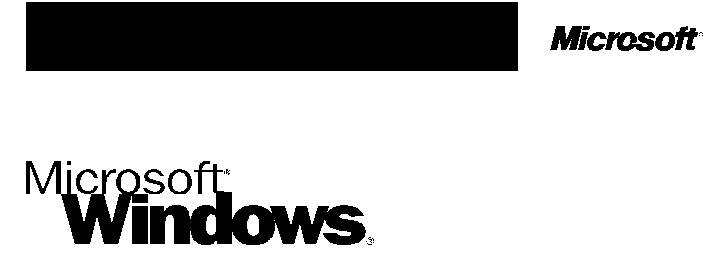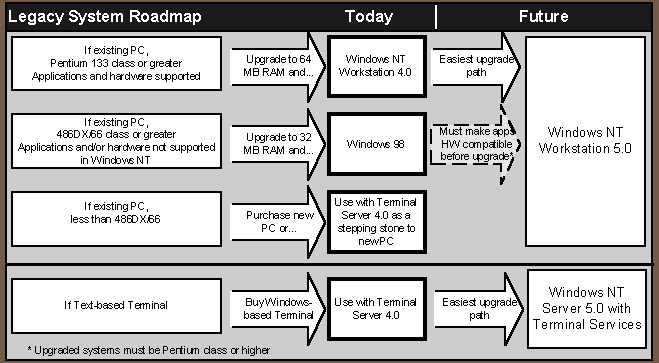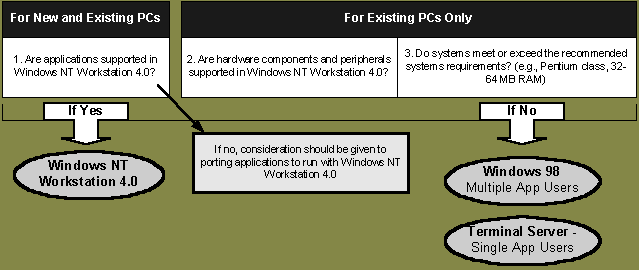
Operating System
Choosing the Best Windows Desktop Platform
For Large and Medium-Sized Businesses and Organizations
White Paper
June, 1998
© 1998 Microsoft Corporation. All rights reserved.
The information contained in this document represents the current view of Microsoft Corporation on the issues discussed as of the date of publication. Because Microsoft must respond to changing market conditions, it should not be interpreted to be a commitment on the part of Microsoft, and Microsoft cannot guarantee the accuracy of any information presented after the date of publication.
This document is for informational purposes only. MICROSOFT MAKES NO WARRANTIES, EXPRESS OR IMPLIED, IN THIS DOCUMENT.
Microsoft, MS-DOS, Windows and Windows NT are either registered trademarks or trademarks of Microsoft Corporation in the United States and/or other countries. Other product and company names mentioned herein may be the trademarks of their respective owners.
0698
ABSTRACT
DEPLOYMENT RECOMMENDATIONS SUMMARY
When Purchasing New PCs
When Upgrading Existing Systems
COMPARING THE PLATFORMS
Windows NT Workstation 4.0
Windows 98
Windows-Based Terminals and Terminal Server
Coming Soon: Windows NT Workstation 5.0
PREPARING FOR WINDOWS NT WORKSTATION
Purchasing New PCs
Automating Windows NT Workstation 4.0 Deployment
CONCLUSIONThis document provides Microsoft’s operating system deployment recommendations for business desktops – today and for the next few years. Supporting information describes how Microsoft arrived at these deployment recommendations. Keep in mind that every business and desktop environment is unique, so these recommendations should be considered general guidelines. Systems should be tested before deploying.
Most importantly, Microsoft recommends that businesses move to 32-bit Windows®-based applications. Modern 32-bit applications offer greater reliability, better performance, lower total cost of ownership (TCO), better productivity, and more security than 16-bit Windows-based and MS-DOS®-based applications. In addition, 32-bit applications are best poised to take advantage of hardware and operating system innovations.


Microsoft recommends moving existing "optimized" desktops (i.e., Pentium-class CPU, 64 MB RAM, and compatible hardware and software) to Windows NT Workstation 4.0. This provides existing desktops with the same benefits as new PCs. Microsoft offers several tools for qualified IT professionals that automate the deployment of Windows NT Workstation 4.0. (Customers moving to Windows NT Workstation 4.0 from Windows 95 should be aware that machine and user specific settings and applications must be reapplied after installing Windows NT Workstation 4.0.)
Most desktops that cannot be moved to Windows NT Workstation 4.0 can benefit from the Windows 98 operating system. Windows 98 is easier to deploy and support than Windows 95. In addition, because upgrade processes cannot easily replicate a user’s personal settings and applications, it’s often simpler to move capable Windows 95-based desktops to Windows 98. For upgrading to Windows NT Workstation 5.0, Microsoft plans an automated upgrade path from Windows 98 (and the Windows 95 operating system), but this will require additional steps when compared with upgrading from Windows NT Workstation 4.0. For more information on Windows 98, see Section III.
For desktops that cannot be upgraded to Windows NT Workstation 4.0 or Windows 98, Microsoft recommends purchasing new PCs with Windows NT Workstation 4.0. During the process of acquiring new PCs, Windows NT Server 4.0, Terminal Server Edition can be used as a stepping stone. Terminal Server eases the changeover by giving legacy desktop users the power of 32-bit Windows-based applications. For more information on the benefits of Windows NT Server 4.0, Terminal Server Edition, see Section III.
Businesses that use text-based terminals can purchase new Windows-based Terminals. This move provides "task users" access to 32-bit Windows-based applications in the secure, reliable environment of Windows NT Server 4.0.
Finally, except in rare instances, Windows 95 should not continue being deployed. Businesses committed to Windows 95 – and that cannot move desktops to Windows NT Workstation 4.0 – should deploy Windows 98 instead of Windows 95. Windows 98 is easier to deploy and support and does not require extensive reevaluation in order to switch from an existing Windows 95 deployment plan. New PCs should include 64 MB RAM.
Windows NT Workstation 4.0 and Windows 98 are both modern 32-bit desktop operating systems. While each operating system includes a unique set of core strengths, Windows NT Workstation 4.0 is considered the Microsoft "business" operating system and Windows 98 is considered the Microsoft "consumer" operating system. The following outlines a high-level summary comparing the different platforms. Additional details can also be found on
http://www.microsoft.com/windows/
Windows NT Workstation 4.0 Windows NT Workstation 4.0 focuses on reliability, manageability, security, and performance. Its multithreaded, kernel-based architecture is optimized to run modern 32-bit Windows-based applications, while also supporting many leading MS-DOS-based and 16-bit Windows-based business applications. Windows NT Workstation 4.0 supports more than 4,000 hardware devices and peripherals. Portable users now can take advantage of Plug and Play and power management tools from third-party vendors. With a shared architecture, Windows NT Workstation 4.0 is also the best networking client to the scalability, manageability and performance of Windows NT Server 4.0.Windows NT Workstation 4.0 core strengths, as compared with Windows 95, include:
).
Windows 98 Windows 98 is a smart upgrade for desktops that cannot be moved to Windows NT Workstation 4.0. In addition to thousands of refinements, Windows 98 is easier to deploy and support than Windows 95, and enables a new generation of innovative hardware. Highlights, as compared to Windows 95, include:
However, Microsoft recommends two scenarios where thin clients can be effectively deployed:
More information on Terminal Server and Microsoft's thin-client strategy can be found on http:/www.microsoft.com/ntserver.
Coming Soon: Windows NT Workstation 5.0 The Windows NT Workstation 5.0 operating system promises to combine the best of Windows 98, including native Plug and Play and power management, while significantly extending the manageability, reliability, security, and performance of Windows NT Workstation 4.0. In fact, improved management capabilities are expected to reduce TCO as much as 50 percent or more over other Windows-based environments. For more information on the features and benefits of Windows NT Workstation 5.0, go tohttp://www.microsoft.com/ntworkstation/basics/ntw5/
The following summary highlights key capabilities:
-
Plug and Play-
Power management-
Enhanced security with Kerberos 5 and Encrypted File System-
Support for new hardware-
Document and user settings management-
Application deployment and updating-
Centralized, policy-based management-
Machine replacementAlthough all 32-bit Windows operating systems are scheduled for upgrades, Microsoft believes that the best way to prepare for Windows NT Workstation 5.0 is to deploy Windows NT Workstation 4.0 today. Because of its shared registry, corresponding application programming model and other common components, Windows NT Workstation 4.0 promises to be the easiest upgrade path to Windows NT Workstation 5.0. For example, Windows 98 and Windows 95-based applications will often require a special conversion tool (called migration.dll) in order to be moved to Windows NT Workstation 5.0. Moreover, each application is unique and may require its own conversion program. Windows NT Workstation 4.0-based applications will be upgraded automatically to Windows NT Workstation 5.0. Also, though support will be expanded slightly, most applications that do not run under Windows NT Workstation 4.0 are not expected to run under Windows NT Workstation 5.0.
It is also important to note that all users who want to upgrade will eventually need to move to the Windows NT product family as Windows 98 is the last major upgrade planned for the Windows 9x architecture. Microsoft is planning future desktop operating system development around the Windows NT architecture.
It is important to evaluate an existing environment for application and hardware compatibility. In general, new PCs preinstalled with Windows NT Workstation 4.0 need to be evaluated only for application compatibility. If applications are found to be not compatible with Windows NT Workstation 4.0 (especially legacy applications), then businesses should weigh the TCO impact of using legacy applications against the benefits of building modern 32-bit Windows-based programs that can take full advantage of today’s hardware and operating system platforms. If a business is switching existing desktops to Windows NT Workstation 4.0, applications as well as hardware compatibility and system requirements need to be considered. The following chart provides a simple evaluation method:

To help with this evaluation Microsoft maintains several Web-based resources:
-
Commercial MS-DOS-based and 16-bit applications:http://microsoft.com/windows/platform/info/16bit.htm
-
Commercial 32-bit applications:·
Is existing hardware compatible with Windows NT Workstation 4.0?-
Hardware compatibility list:http://www.microsoft.com/hwtest/
It’s important to note that Microsoft focuses on the listing only popular commercially available products. Most line-of-business applications and no "custom" applications appear on the list.
Purchasing New PCs While the economics of replacing versus upgrading is outside the scope of this paper, Microsoft recommends using the following guidelines when purchasing new PCs. Businesses are always best advised to purchase the highest end systems possible. The following base guidelines ensure a productive user experience as well as the ability to take advantage of software management features. These systems will also be Windows NT Workstation 5.0-"ready."Businesses moving Windows 95 desktops to Windows NT Workstation can automate and customize deployment using a variety of methods.
More information on moving to Windows NT Workstation 4.0 can be found at
http://www.microsoft.com/ntworkstation/
Microsoft’s foremost recommendation is to move to 32-bit Windows-based applications. New PCs should have the Windows NT Workstation 4.0 operating system preinstalled with a minimum of 64 MB RAM. Capable existing PCs should be moved to Windows NT Workstation 4.0. Most PCs that are not capable of being moved to Windows NT Workstation 4.0 should be upgraded to Windows 98. For existing Windows 3.x desktops that cannot be upgraded to Windows NT Workstation 4.0 or Windows 98, Microsoft recommends purchasing new PCs (with Windows NT Workstation 4.0 pre-installed) and redeploying legacy systems as terminal emulators.
The End